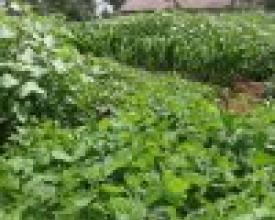
USING BIOINTENSIVE AGRICULTURE TO IMPROVE NUTRITION, INCOME AND FOOD SECURITY

The concept of food and nutritional security refers to the ability of all people at all times to have physical and income access to sufficient, safe and nutritious food to meet their dietary needs for an active healthy life. It requires food being available enough, stable and accessible; without which inevitably leads to malnourishment that hinders individual performance.
Any enhancement of the food security calls for farmers’ sensitization and encouragement to adopt strategic methods that will not only cater to food and nutritional security but also income at a household level and sound management of the environment.
Climate change will affect availability, stability, utilization, and access to food security …(UN-ESCAP: Agriculture and Food Security, Asia)
When we farm in a way that maximizes the amount of carbon captured in our crops, and we return as much of that carbon as possible to the soil, we can effectively remove carbon dioxide from the atmosphere and store it in the soil.
Contexte
Challenges addressed
Biointensive Agriculture (BIA) is a low-cost way of farming. It uses locally available materials. BIA uses of manure (compost) to improve soil fertility, deep land preparation to enhance soil structure and aeration, close spacing to increase productivity, companion planting for mutual benefits, high carbon & calorie yields for unit design, open pollinated crops for conservation of genetic material, nonchemical pest and disease management to reduce costs and health risk and whole gardening system to maximize benefits. It can produce 2 to 4 times the yields in the same area.
BIA techniques have demonstrated energy production efficiency. This combination of renewable energy, and dramatic energy-use reduction through efficiency, results in a significant reduction of greenhouse gases. It does not require the use of fossil fuels, so its widespread use would greatly reduce the amount of carbon dioxide being emitted by agriculture into the atmosphere.
Emplacement
Traiter
Summary of the process
After TOTs have been impacted with skills, follow up is conducted to enhance adoption of BIA. Farmers interact with subject matter specialist and share experiences. This will guarantee continuity and at the same time induce intra-community knowledge and idea transfer. To achieve this, the deployed field team will use different methods. This includes public rallies, field days, visits to existing farmers’ groups and impromptu farm visits to establish contacts and enhance outreach. Different groups may carry out need assessment and start income generating projects
Building Blocks
Training of farmers
The method used in training involves introductory lessons on Biointensive agriculture and other sustainable ideas carried out indoors. After this familiarization with the concepts, the trainees are subjected to demonstrations to aid in acquiring of relevant practical skills and finally participatory action based on-farm training. Discussions and sharing of ideas and experiences are highly encouraged at this stage and upholding is equally emphasized. Thematic approaches based on soil conservation, long-term soil fertility building, ecological farm management practices and energy saving are stressed.
Enabling factors
The community members will have an interest in sustainable methods of farming – Biointensive agriculture i.e. avail themselves for the trainings, and play their duly part during training and implementation of the project in order to make a lasting impact.
Lesson learned
- Farmers are aware of the benefits ecological method of farming
- The farmers are willing to adopt the ecological farming
- The farmers fully participated in the whole session of training
Follow Ups & extension
Trained farmers are offered post training services geared towards a smooth transition to sustainable practices. These include continuous and regular visits by the field based staff in order to guide, advise, direct and motivate them. Planning for real at this stage emerges given that the community members come up with various strategic livelihood improvement projects. The experts usually discuss their priorities with the farmers and develop appropriate interventions.
Enabling factors
The social-economic, political and weather conditions will allow for the process of awareness, training and more importantly adoption and the implementation of the ideas.
Lesson learned
- The trained TOTs have trained their farmer groups
- There is a need for continuous follow-ups
- The trained farmers have established demo sites in their communities
Impacts
BIA can be used for sustainable crop production; its focus is on creating nutritionally complete diets primarily from grain, legume, vegetable and root crops in order to minimize the total area needed to feed ourselves.
The positive impact on the farmers adopting this model is seen in regard to soil regeneration, food, nutrition, health, income and suitability of the whole gardening system is great. Adversities in a climatic change such as desertification and effects of global warming will have been mitigated. BIA uses much less energy compared with conventional agriculture and as little as 1% to 6% of the fossil fuel compared to consumption rates of conventional agriculture.
Farmers learn by doing at their mini training centers. The demo sites serve to pass information through the society. Other stakeholders use such forums to introduce development agendas in the community and even for civic education like voter registration. BIA is labor intensive, so it has helped in reducing idleness of members of the community and occupied youths in manual work, thus giving no time for getting involved in petty crimes due to idleness.
The BIA technology is promoted alongside suitable enterprises such as beekeeping, agro-forestry etc. These will result in integrated sustainable economic development via a whole system approach to farming for biodiversity and improving environment conservation.
Beneficiaries
The target beneficiaries are the small scale holders who are most affected by the prohibitive cost of agricultural production and the escalating land degradation through contamination by toxic inputs and loss of fertility through erosion.





